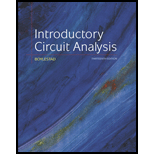
Introductory Circuit Analysis (13th Edition)
13th Edition
ISBN: 9780133923605
Author: Robert L. Boylestad
Publisher: PEARSON
expand_more
expand_more
format_list_bulleted
Concept explainers
Textbook Question
Chapter 1, Problem 16P
Repeat Problem 15 using hundredths-place accuracy.
Expert Solution & Answer
Want to see the full answer?
Check out a sample textbook solution
Students have asked these similar questions
Solve by Hand not using AI or chatgpt
Fundamentals of Energy Systems HW3 Q4
Fundamentals of Energy Systems HW3 Q2
Chapter 1 Solutions
Introductory Circuit Analysis (13th Edition)
Ch. 1 - Visit your local library (at school or home) and...Ch. 1 - Choose an area of particular interest in this...Ch. 1 - Choose an individual of particular importance in...Ch. 1 - In a recent Tour de France time trial, a...Ch. 1 - Outside the United States speed is measured in...Ch. 1 - Prob. 6PCh. 1 - A pitcher has the ability to throw a baseball at...Ch. 1 - Are there any relative advantages associated with...Ch. 1 - Which of the four systems of units appearing in...Ch. 1 - Which system of Table 1.1 is closest in definition...
Ch. 1 - What is room temperature (68F) in the MKS, CGS,...Ch. 1 - How many foot-pounds of energy are associated with...Ch. 1 - In Europe the height of a man or woman is measured...Ch. 1 - Throughout the world, the majority of countries...Ch. 1 - Write the following numbers to tenths-place...Ch. 1 - Repeat Problem 15 using hundredths-place accuracy.Ch. 1 - Repeat Problem 15 using thousandths-place...Ch. 1 - Express the following numbers as powers of ten to...Ch. 1 - Using only those powers of ten listed in Table 1.2...Ch. 1 - Perform the following operations to...Ch. 1 - Prob. 21PCh. 1 - Perform the following operations to...Ch. 1 - Perform the following operations: 10010,000...Ch. 1 - Perform the following operations to...Ch. 1 - Prob. 25PCh. 1 - Perform the following operations to...Ch. 1 - Perform the following operations to...Ch. 1 - Write the following numbers in scientific and...Ch. 1 - Write the following numbers in scientific and...Ch. 1 - Perform the following operations and leave the...Ch. 1 - Fill in the blanks of the following conversions:...Ch. 1 - Perform the following conversions: 0.05 s to...Ch. 1 - Perform the following conversions to...Ch. 1 - Perform the following metric conversions to...Ch. 1 - Perform the following conversions between systems...Ch. 1 - What is a mile in feet, yards, meters, and...Ch. 1 - Convert 60 mph to meters per second.Ch. 1 - How long would it take a runner to complete a...Ch. 1 - Quarters are about 1 in. in diameter. How many...Ch. 1 - Compare the total time required to drive a long,...Ch. 1 - Find the distance in meters that a mass traveling...Ch. 1 - Each spring there is a race up 86 floors of the...Ch. 1 - The record for the race in Problem 42 is 10.22...Ch. 1 - Prob. 44PCh. 1 - Using Appendix A, determine the number of Btu in 5...Ch. 1 - 6(42+8)=Ch. 1 - Prob. 47PCh. 1 - 52+(23)2=Ch. 1 - cos21.87=Ch. 1 - tan134=Ch. 1 - 40062+105=Ch. 1 - 8.21030.04103 (in engineering notation) =Ch. 1 - (0.06105)(20103)(0.01)2 (engineering notation) =Ch. 1 - 41042103+400105+12106 (in engineering notation) =Ch. 1 - Investigate the availability of computer courses...Ch. 1 - Prob. 56P
Knowledge Booster
Learn more about
Need a deep-dive on the concept behind this application? Look no further. Learn more about this topic, electrical-engineering and related others by exploring similar questions and additional content below.Similar questions
- I need help with this problem and an explanation of the solution for the image described below. (Introduction to Signals and Systems)arrow_forwardNO AI PLEASE.arrow_forward2-3) For each of the two periodic signals in the figures below, find the exponential Fourier series and sketch the magnitude and angle spectra. -5 ΟΙ 1 1- (a) (b) -20π -10x -π Π 10m 20m 1-arrow_forward
- I need help with this problem and an explanation of the solution for the image described below. (Introduction to Signals and Systems)arrow_forwardIn the op-amp circuit shown in Fig. P8.32,uin(t) = 12cos(1000t) V,R = 10 k Ohm , RL = 5 k Ohm, and C = 1 μF. Determine the complexpower for each of the passive elements in the circuit. Isconservation of energy satisfied?arrow_forward2-4) Similar to Lathi & Ding prob. 2.9-4 (a) For signal g(t)=t, find the exponential Fourier series to represent g(t) over the interval(0, 1). (b) Sketch the original signal g(t) and the everlasting signal g'(t) represented by the same Fourier series. (c) Verify Parseval's theorem [eq. (2.103b)] for g'(t), given that: = n 1 6arrow_forward
- 8.24 In the circuit of Fig. P8.24, is(t) = 0.2sin105t A,R = 20 W, L = 0.1 mH, and C = 2 μF. Show that the sum ofthe complex powers for the three passive elements is equal to thecomplex power of the source.arrow_forward3. VEB (on) 0.7 V, VEC (sat) = 0.2 V, and ẞ = 150. RB = 50 kQ, Rc = 2 kQ, and Vcc = 5 V. a) Find the range of V₁ for the cut-off. Forward active, and saturation regions. (20 points) b) Draw the voltage transfer characteristic (VTC) graph. (10 points) Vcc VEB V₁ RB www 。 Vo Rc Figure 3arrow_forward2-1) Lathi & Ding prob. 2.5-2 For the signals y(t) and x(t) shown below, find the component of the form y(t) contained in x(t). In other words, find the optimum value of c in the approximation x(t) = cy(t) so that the error signal energy is minimum. Also compute the error signal energy. y(t) x(t) 0 1 0 1arrow_forward
arrow_back_ios
SEE MORE QUESTIONS
arrow_forward_ios
Recommended textbooks for you
 Delmar's Standard Textbook Of ElectricityElectrical EngineeringISBN:9781337900348Author:Stephen L. HermanPublisher:Cengage Learning
Delmar's Standard Textbook Of ElectricityElectrical EngineeringISBN:9781337900348Author:Stephen L. HermanPublisher:Cengage Learning

Delmar's Standard Textbook Of Electricity
Electrical Engineering
ISBN:9781337900348
Author:Stephen L. Herman
Publisher:Cengage Learning
What is an electric furnace and how does it work?; Author: Fire & Ice Heating and Air Conditioning Inc;https://www.youtube.com/watch?v=wjAWecPGi0M;License: Standard Youtube License